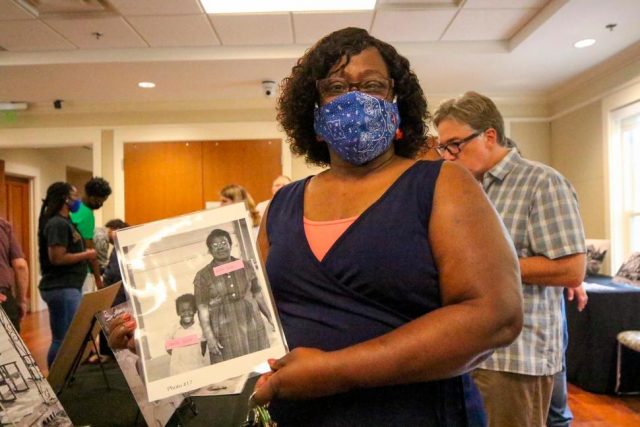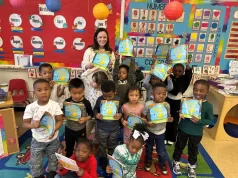
The Associated Press
By ABBY DRIGGERS, Opelika-Auburn News
A phrase often repeated at the Caroline Marshall Draughon Center for the Arts & Humanities at Pebble Hill on June 6 started with “That’s…”
“That’s my dad.”
“That’s my aunt.”
“That’s me.”
These words were spoken by former residents of Draketown, an African-American neighborhood in Auburn, who were seeking to identify people in 32 never-before-seen photographs taken by an Auburn University student named William Wright in the 1960s.
They lined up along tables filled with the photographs, often conferring with family and friends before reaching a consensus, and then they put pen to paper and wrote down the names belonging to the pictured faces.
The center had organized the two-hour event to do just that: name the nameless.
When the center’s director, Mark Wilson, received a call in October from Wright’s sister asking if the university wanted the photographs, Wilson did not hesitate. And when the first 12 developed photographs arrived from the former Auburn University student, Wilson knew the center had stumbled onto something special.
“It feels great to get the photographs back into the hands of the folks who were photographed,” Wilson said, “and it’s good to witness people remembering their own history and their neighbors’ history and be able to be a part of the future of this history.”
Draketown is largely unknown by current residents of Auburn, but to those who grew up in it, it’s considered to be both a community of the past and the present. They identify Draketown by its streets: North Gay Street, North Avenue, Pitts Circle and others.
Chance To Remember
Last Sunday, many familiar with Draketown got the chance to remember.
“It was a vibrant, happening place,” said Frank Reese, 66. “My granddaddy lived in Draketown, my wife was born in Draketown — it was a good, happy place.”
Reese grew up at 605 Spencer Avenue, one of a few remaining houses still standing today, he says. As a kid, he would cut through Cary Woods and walk the “mile or so” to Draketown to visit with classmates.
When a relative asked Juanita Edwards Parham if she could name the unnamed gentlemen in the photograph published with a front-page story in last Saturday’s Opelika-Auburn News, she could. He was Willie Gipson, a common figure in the neighborhood.
“That’s Willie all right,” she said, after walking into the center and seeing the newspaper. She says Gipson would help clean the “red dirt roads.”
The topic of the roads came up often at the event. Edward Cobb, 69, says they were paved sometime in the 1970s.
Iris Canon, 58, said her grandmother had chickens and other farm animals in the neighborhood.
The woman wearing glasses in photo No. 24 was Eva Collins, who died about four months ago, according to Mary Anne Wright Patrick, whose family ran the pictured Wright’s Grocery Store. She said she wished her parents and grandparents could have seen the photographs, and many others in attendance Sunday echoed the sentiment.
“These are forever photographs,” said Alicia Martin, who left the center with copies of photographs containing family members. “I had chills when I first saw them,” she said. “I just wish they could see them.”
When Shelia Dallas walked into the center, she did not expect to see her mother, Ruth, in one of the photographs. And when she saw herself, holding her mother’s hand, she had no words.
“That’s my front porch, that’s our house,” said Dallas said, guessing she was about 6 years old. “I’ve never seen a photo of me this young.”
Dallas and other former residents of Draketown said they don’t have many photographs of themselves as young children. She says she hopes to grab a copy to show other family members.
‘A Good Thing’
John Hardin, museum division director of the Alabama Department of Archives & History, watched as local residents went to a corner of the room to look at copies of the photos and place them on 1960s-era maps of Draketown streets in the corresponding spot where they were taken.
“We realize how rare it is for these photographs to pop up out of nowhere,” Hardin said. “They’re rare. They’re beautiful and valuable for the community they portray and for the whole Auburn, Lee County community.
“It’s a way to create community connections and get a portal into the past that we don’t always have.”
As for what’s next for the photographs, Wilson says that will be decided by former Draketown residents themselves.
“We’re going to let the community help us determine the meaning of them and then we’ll figure out what life they have beyond this day.”
Johnny Jackson, 73, grew up near Chewacla State Park but was friends with many of the photographed school children. He agreed with other community members that reliving memories is a joy.
“I don’t know who took these,” Jackson said, “but they did a good thing.”




